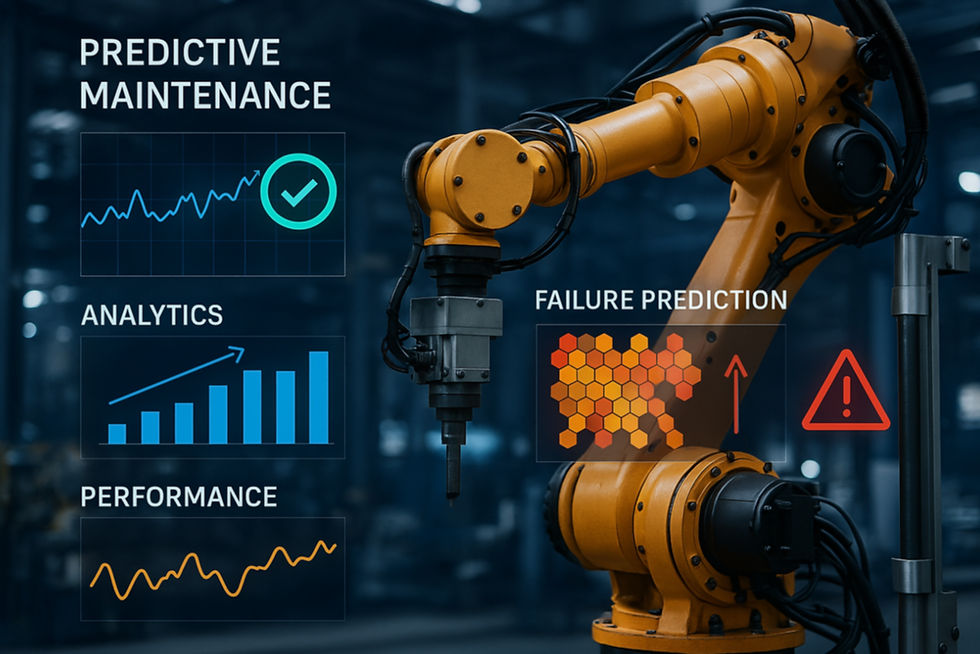Predictive Analytics in Manufacturing: From Data to Proactive Decision-Making (July 2025)
- Adriana Gutierrez, Digital Media Producer

- 28 jul
- 3 Min. de lectura

Manufacturing operations are data powerhouses. Every machine, every sensor, and every process generates a vast stream of information. Historically, much of this data was used for reactive problem-solving or historical reporting. However, in July 2025, leading manufacturers are moving beyond simply understanding what happened to anticipating what will happen. This transformative shift is powered by predictive analytics, converting raw data into actionable, forward-looking insights that drive unprecedented levels of efficiency, quality, and operational excellence.
What is Predictive Analytics in Manufacturing?
At its core, predictive analytics in manufacturing involves using historical data, statistical algorithms, and machine learning techniques to identify the likelihood of future outcomes. Instead of just reacting to events, manufacturers can now foresee potential issues, optimize processes before problems arise, and make informed decisions with a much higher degree of certainty. It's about empowering proactive management across the entire production lifecycle.
Key Applications Transforming Manufacturing Operations
The power of predictive analytics is being applied across various critical areas within the manufacturing sector:
Predictive Maintenance: Maximizing Uptime and Asset Life
This is perhaps the most well-known application. Sensors on machinery collect data on temperature, vibration, pressure, and operational cycles. Predictive algorithms analyze this data to forecast equipment failures before they occur, allowing maintenance teams to schedule interventions precisely when needed, rather than on a fixed schedule or after a breakdown (PwC, Industry 4.0: Predictive Analytics in Manufacturing, February 2025). This significantly reduces unplanned downtime, extends asset lifespan, and lowers maintenance costs.
Demand Forecasting: Optimizing Production and Inventory
By analyzing historical sales data, market trends, economic indicators, and even real-time social media sentiment, manufacturers can generate highly accurate demand forecasts. This enables optimized production schedules, reduced overproduction or stockouts, and more efficient inventory management, directly impacting profitability and customer satisfaction (Gartner, Top 10 Data and Analytics Trends 2025, March 2025).
Quality Prediction: Preventing Defects Before They Occur
Predictive analytics can monitor production parameters in real time and identify subtle deviations that indicate a potential quality issue. By analyzing data from sensors, inspection systems, and process controls, manufacturers can predict potential defects or product variations early in the production cycle, allowing for immediate corrective action (IBM, Supply Chain Resilience Trends 2025, June 2025). This leads to higher first-pass yield, reduced scrap, and superior product quality.
Supply Chain Risk Anticipation: Building Resilience
Beyond traditional supply chain visibility, predictive analytics helps manufacturers anticipate potential disruptions in their supply chains. This includes forecasting geopolitical instability, predicting supplier financial distress, identifying potential weather-related logistics delays, or even anticipating material shortages based on global market signals (Deloitte, Global Supply Chain Trends 2025, May 2025). This enables proactive contingency planning and diversified sourcing strategies.
Process Optimization: Enhancing Efficiency and Performance
By analyzing historical and real-time process data, predictive models can identify optimal operating parameters for machines and production lines. This allows manufacturers to fine-tune processes to maximize throughput, minimize energy consumption, or improve resource utilization, leading to continuous efficiency gains (Capgemini Research Institute, The Intelligent Industry in 2025, 2024).
From Reactive to Proactive: The Strategic Shift
The transition to predictive analytics marks a fundamental shift in how manufacturing operations are managed:
From Reactive to Proactive: Instead of responding to problems, manufacturers can anticipate and prevent them.
From Intuition to Data-Driven Decisions: Gut feelings are replaced by insights derived from objective data.
From Siloed Information to Integrated Intelligence: Data from various sources is combined to create a holistic view of operations, fostering better cross-functional collaboration.
This proactive approach leads to significant advantages: reduced operational costs, minimized downtime, enhanced product quality, improved resource allocation, and a greater ability to adapt to market changes. Manufacturers who embrace predictive analytics gain a powerful competitive edge by running smarter, more efficient, and more resilient operations (PwC, Industry 4.0: Predictive Analytics in Manufacturing, February 2025).
Conclusion
In July 2025, predictive analytics is no longer a futuristic concept; it's a tangible reality delivering measurable value across the manufacturing sector. By strategically leveraging the vast amounts of data at their disposal, manufacturers are moving beyond mere data collection to sophisticated foresight. This capability empowers them to predict failures, optimize processes, forecast demand, and mitigate risks, transforming their operations from reactive to truly proactive. Embracing predictive analytics is a critical step for any manufacturer aiming to achieve peak performance, sustainable growth, and unwavering competitiveness in the dynamic global market.


